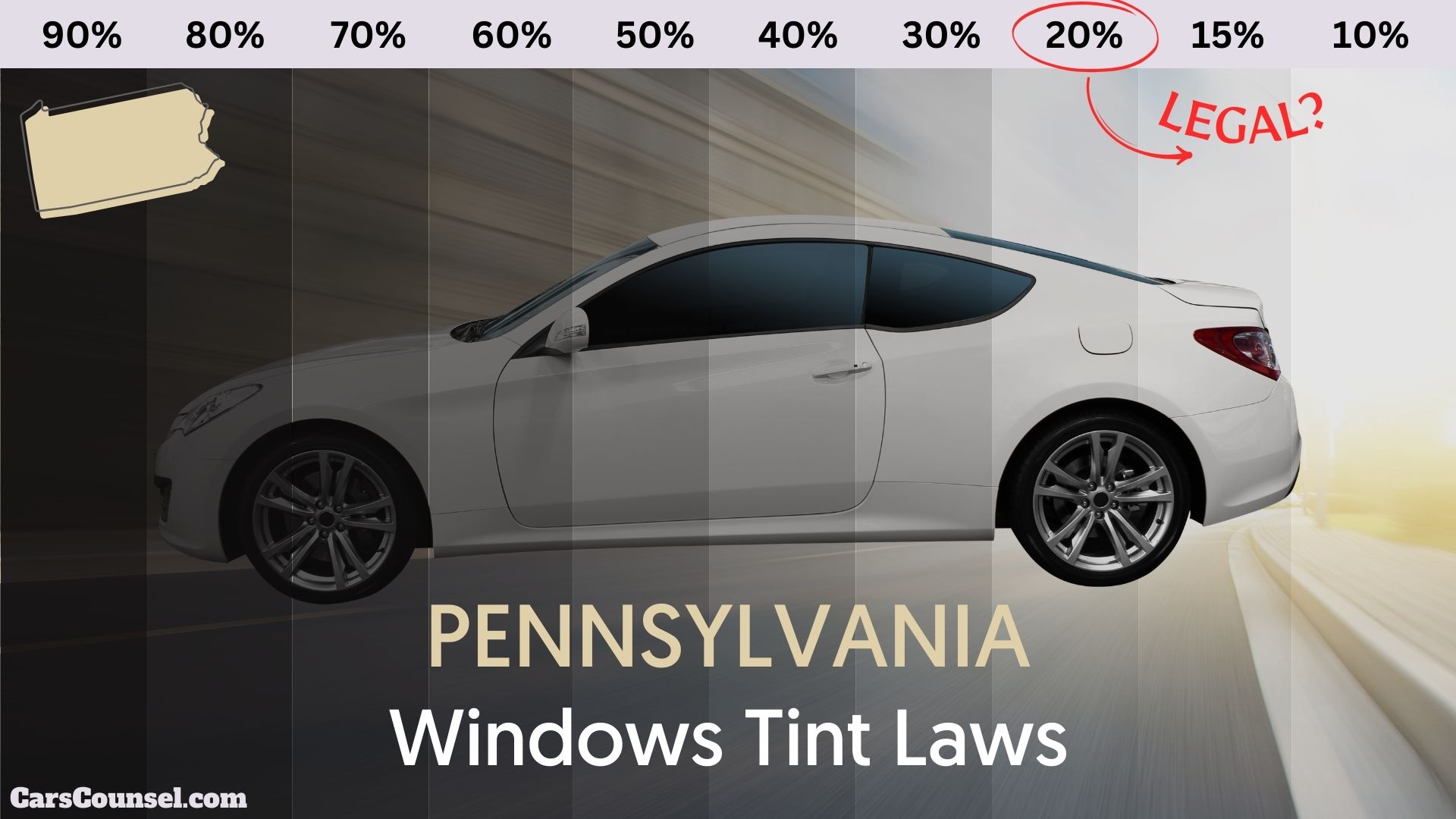As you cruise down the Pennsylvania Turnpike on a sunny day, the glare from the asphalt can be blinding, making you wonder if your window tint is doing its job. But did you know that the Keystone State has specific laws governing window tinting? From the percentage of visible light allowed to pass through to medical exemptions, there’s more to it than just aesthetics.
If you’re a vehicle owner in Pennsylvania, it’s vital to understand these regulations to avoid getting pulled over and slapped with a hefty fine. But what exactly are the rules, and how can you verify you’re in compliance?

Quick Navigation
Pennsylvania Window Tint Laws
Pennsylvania’s car window tinting laws were established in 1999 to regulate the visual properties of vehicle windows, ensuring safety and compliance with state standards. This guide provides an extensive overview of the specifications for window tint darkness, reflectivity, and other related regulations within the state. Whether you are a vehicle owner or a professional installer, understanding these guidelines is crucial for legal compliance and optimal vehicle use.
Visible Light Transmission (VLT) Requirements
The Visible Light Transmission (VLT) percentage is crucial in determining the darkness of the window tint. VLT is a measure of the amount of visible light passing through the car windows, and different standards apply depending on the type of vehicle. Here’s a detailed look at the VLT requirements for different vehicles:
Sedans
- Windshield: A minimum of 70% of light must be let in, but tinting is allowed on the top 3 inches to block solar glare.
- Front Side Windows: Must allow more than 70% of light into the vehicle.
- Back Side Windows: Also required to allow in more than 70% of light.
- Rear Window: Must adhere to the same 70% light admittance rule as the side windows.
SUVs and Vans
- Windshield: The same rules apply as with sedans; over 70% VLT is necessary, with an allowance for tint on the upper part of the windshield.
- Front Side Windows: Must maintain a VLT of over 70%.
- Back Side Windows and Rear Window: There is more flexibility with these windows, as any level of darkness can be used. This is particularly useful for privacy and cargo protection in larger vehicles.
[carscounsel_tint_calculator show_state=”true” default_state=”PA”]
Reflectivity and Appearance Regulations
Reflectivity in window tints can help reduce the ingress of heat and light, providing comfort and protection against UV rays. Pennsylvania regulations specify the following about window tint reflectivity:
- All Vehicles: Tints should not have a mirrored or metallic appearance that can excessively reflect incoming light. This rule helps to avoid the blinding of other drivers due to reflective windows.
Additional State Regulations
Apart from VLT and reflectivity standards, Pennsylvania has several other important window tinting rules:
- Side Mirrors: If the rear window is tinted, vehicles must have dual side mirrors. This requirement compensates for reduced rear visibility due to dark tints.
- Restricted Colors: Pennsylvania does not restrict the color of tints, which means that vehicle owners have the freedom to choose any tint shade that complies with VLT regulations.
- Certificates: Unlike some states, Pennsylvania does not require film manufacturers to certify the tint films sold within the state. However, compliance with state VLT and reflectivity standards is mandatory.
- Stickers: Pennsylvania law mandates that a sticker be displayed to indicate legal compliance of window tinting. This sticker should be placed on the inside of the driver’s side window.
- Medical Exemptions: The state provides allowances for darker tints if there are medical necessities. Individuals with specific medical conditions that require protection from direct sunlight can apply for exemptions. These conditions must be verified by a licensed physician, and the approved tint must still adhere to safety standards.
Enforcement and Compliance
Local DMV offices and law enforcement agencies are responsible for ensuring that vehicle tints meet Pennsylvania’s legal standards. Vehicle owners are advised to keep abreast of these regulations to avoid penalties and to ensure that their vehicle tints provide both comfort and safety without violating state laws.
It is recommended to regularly consult local authorities or the DMV to confirm that your vehicle remains compliant with any updates to the tinting laws. As of the last update in 2024, these rules remain current, but they are subject to change based on legislative revisions.
Understanding and adhering to Pennsylvania’s window tinting laws is essential for all vehicle owners and tinting professionals in the state. By complying with these detailed regulations, you can ensure that your vehicle meets all legal requirements, enhancing your driving experience while staying on the right side of the law. Always check with the local DMV or law enforcement to verify the latest in window tinting regulations.
Tint Law References
Pennsylvania Department of Transportation: Vehicle Window Tint Fact Sheet (.pdf file)
Pennsylvania Code Title 75 – VEHICLES, § 4524
PA Code Chapter 175 Title 67: § 175.67. Glazing
Car Window Tinting Laws By State
Click on the state you’re interested in for a complete guide to its tint laws and regulations. If you spot any errors, let us know through our contact page.
| State | Front Side Windows | Back Side Windows | Rear Windows | Windshield |
|---|---|---|---|---|
| Alabama | 32% | 32% | 32% | 6 inches |
| Alaska | 70% | 40% | 30% | 5 inches |
| Arizona | 33% | ANY | ANY | tinting allowed to the top of the manufacturer’s as-1 line |
| Arkansas | 25% | 25% | 10% | 5 inches |
| California | 70% | ANY | ANY | 4 inches |
| Colorado | 27% | 27% | 27% | 4 inches |
| Connecticut | 35% | 35% | ANY | non-reflective tint above the as-1 line top 6 inches |
| Delaware | 70% | ANY | ANY | non-reflective tint above the as-1 line top 6 inches |
| Florida | 28% | 15% | 15% | non-reflective tint above the as-1 line |
| Georgia | 32% | 32% | 32% | 6 inches |
| Hawaii | 35% | 35% | 35% | Non-reflective tint is allowed on the top 4 inches of the windshield |
| Idaho | 35% | 20% | 20% | non-reflective tint above the as-1 line |
| Illinois | 35% | 35% | 35% | 6 inches |
| Indiana | 30% | 30% | 30% | non-reflective tint above the as-1 line |
| Iowa | 70% | ANY | ANY | non-reflective tint above the as-1 line |
| Kansas | 35% | 35% | 35% | non-reflective tint above the as-1 line |
| Kentucky | 35% | 18% | 18% | non-reflective tint above the as-1 line |
| Louisiana | 40% | 25% | 12% | non-reflective tint above the as-1 line top 6 inches |
| Maine | 35% | 35% | 35% | top 4 inches |
| Maryland | 35% | 35% | 35% | top 5 inches |
| Massachusetts | 35% | 35% | 35% | top 6 inches |
| Michigan | 35% | ANY | ANY | top4 inches |
| Minnesota | 50% | 50% | 50% | Top 6 inches |
| Mississippi | 28% | 28% | 28% | non-reflective tint above the as-1 line top 5 inches |
| Missouri | 35% | ANY | ANY | non-reflective tint above the as-1 line top 6 inches |
| Montana | 24% | 14% | 14% | non-reflective tint above the as-1 line top 6 inches |
| Nebraska | 24% | 20% | 20% | top 6 inches or as-1 line, whichever comes first |
| Nevada | 35% | ANY | ANY | non-reflective tint above the as-1 line top 6 inches |
| New Hampshire | 35% | 35% | 35% | Allowed for the manufacturer’s AS-1 line |
| New Jersey | Illegal | ANY | ANY | Top 6 inches |
| New Mexico | 20% | 20% | 20% | 5 inches or as-1 line, whichever comes first |
| New York | 70% | 70% | 70% | top 6 inches |
| North Carolina | 35% | 35% | 35% | non-reflective tint above the as-1 line top 6 inches |
| North Dakota | 50% | ANY | ANY | Top 6 inches |
| Ohio | 50% | ANY | ANY | Top 5 inches |
| Oklahoma | 25% | ANY | ANY | 5 inches or as-1 line, whichever comes first |
| Oregon | 35% | 35% | 35% | Top 6 inches |
| Pennsylvania | 70% | 70% | 70% | Top 3 inches |
| Rhode Island | 70% | 35% | 35% | non-reflective tint above the as-1 line top 6 inches |
| South Carolina | 27% | 27% | 27% | non-reflective tint above the as-1 line top 6 inches |
| South Dakota | 35% | 20% | 20% | non-reflective tint above the as-1 line top 6 inches |
| Tennessee | 35% | 35% | 35% | non-reflective tint above the as-1 line top 6 inches |
| Texas | 25% | 25% | 25% | 5 inches or as-1 line, whichever comes first |
| Utah | 43% | ANY | ANY | non-reflective tint above the as-1 line top 4 inches |
| Vermont | 70% | ANY | ANY | ILLEGAL |
| Virginia | 50% | 35% | 35% | non-reflective tint above the as-1 line top 6 inches |
| Washington | 24% | 24% | 24% | Top 6 inches |
| West Virginia | 35% | 35% | 35% | Top 5 inches |
| Wisconsin | 50% | 35% | 35% | non-reflective tint above the as-1 line top 6 inches |
| Wyoming | 28% | 28% | 28% | Top 5 inches or as-1 line, whichever comes first |

